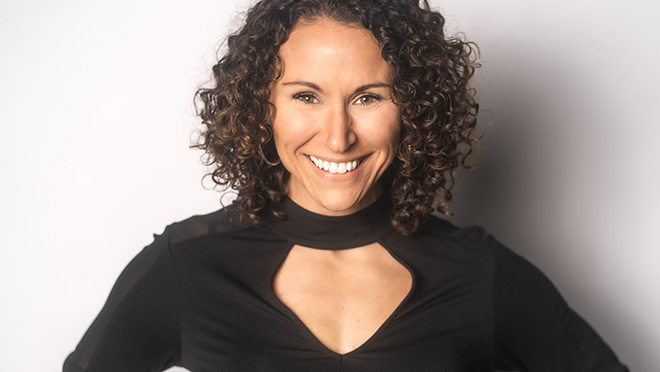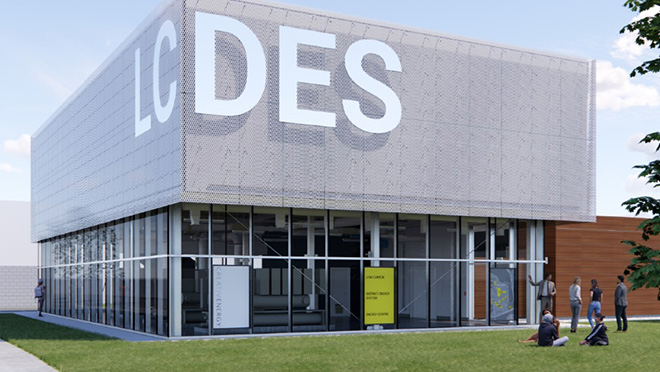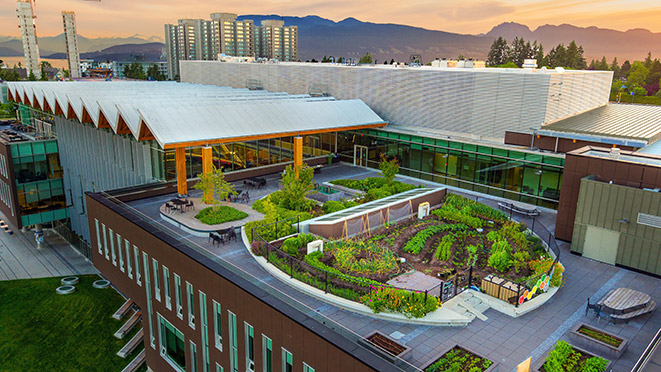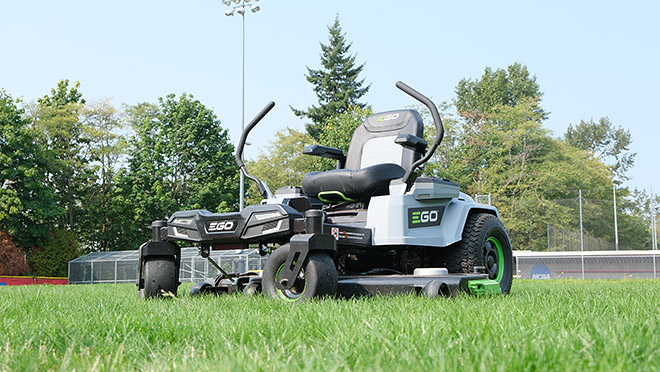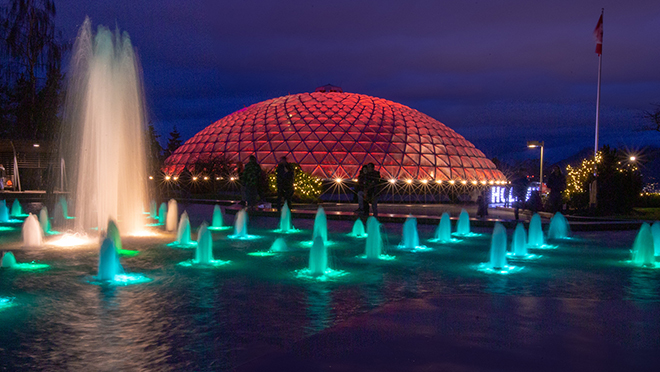Burnaby embraces EVs, district energy to reduce GHG emissions
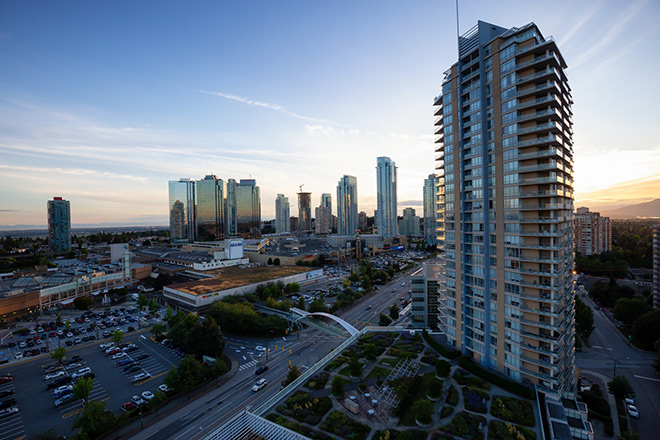
City of Burnaby aims for 45% CO2 emissions reduction by 2030
Part of a series on BC Hydro Clean Energy Champions: businesses, homes, and institutions – large and small – recognized for reducing their reliance on fossil fuels.
The Metro Vancouver Waste-to-Energy facility in Burnaby produces 24 megawatts of electricity a year by taking non-hazardous waste – otherwise destined for landfill – and combusting it to generate steam for electricity generation.
That's enough to power 17,000 homes a year, but Burnaby has plans to get much more out of the facility.
The idea is to use thermal energy from the plant, which processes about 25% of Metro Vancouver's post-recycled waste, for heating and hot water for high-density neighbourhoods beginning with the Metrotown and Edmonds areas. Hot water produced at the plant, transmitted 24/7 through a highly insulated underground network of thermal piping, can be transferred directly to the buildings' heating systems, simplifying building operations.
Burnaby estimates that district energy could reduce the amount of greenhouse gas (GHG) emissions in these neighbourhoods by 82% (22,400 tonnes of CO2e annually).
That's just one of the ways the City of Burnaby is tackling greenhouse gas emissions after declaring a climate emergency in 2019. It's also converting its vehicle fleet to electric, and switching to electric heat pumps for heating and cooling in many city buildings.
The city's climate action targets are a 45% reduction in emissions by 2030, a 75% reduction by 2040, and carbon neutrality by 2050. Those reductions apply to everything from vehicle transportation, to energy use in homes, commercial and industrial facilities.
"The City has shown tremendous dedication on clean energy and energy conservation," says Rick Truong, who works with Burnaby as a BC Hydro key account manager. "We're excited to continue to work with the City to lower carbon emissions."
Burnaby makes switching to clean energy a priority
Brad Domaas is the City's new director of facilities management. And it's a big part of his job to use City of Burnaby-owned buildings and other facilities as examples of how to reduce GHG emissions.
To demonstrate how best to reduce the emissions related to building energy use in particular, Domaas is working closely with BC Hydro to explore the best path to big emissions savings. And one of the key questions is, where's the biggest bang for the buck?
The City has a nice track record of delivering efficiency upgrades, saving 13.45 gigawatt hours in electrical energy to date, thanks in part to $3 million in incentives from BC Hydro. But the focus is no longer on efficiency alone. A lot of buildings have been built or retrofitted before the priority shift to climate action through a switch from fossil fuels to renewable electricity, a process known as electrification.
"One of the challenges is that retrofit costs go up considerably when you go from efficient, to ultra-efficient, to fully electric," says Domaas. "And some of our upgrades and newer buildings didn't take into consideration full electrification. So we've been talking with BC Hydro recently about whether or not the incentive money should shift from retrofits to new construction to help bridge that gap."
The City uses an asset management software system that prioritizes system replacements based on age and condition, while also looking at energy efficiency and whether systems emit greenhouse gases (GHGs). Domaas says all GHG emitting systems go at or near the top of the replacement priority list, and wherever possible, systems that rely on fossil fuels are replaced with electric heat pumps.
Domaas notes that the "low-hanging fruit of lighting upgrades has been largely plucked." That doesn't mean that lighting upgrades are over – the city is looking at switching from tens of thousands of LED holiday lights in favour of new holiday lighting projectors that could save plenty on energy use and maintenance. That follows LED conversions at 29 facilities between 2017 and 2019, which saves an estimated 1.45 million kilowatt hours annually.
But the priority is CO2 emissions. And that's where projects such as district energy, vehicle fleet electrification, building retrofits and new construction that prioritize electrification, come into play.
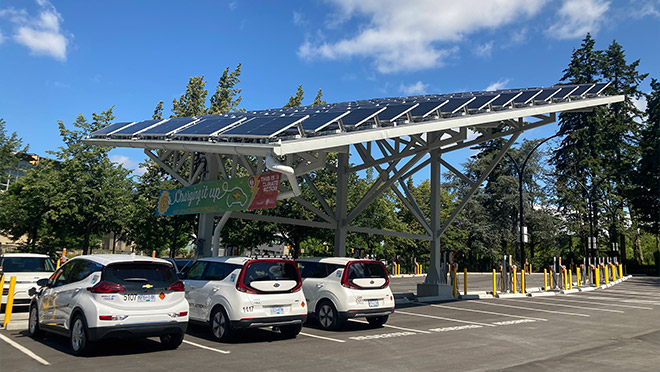
EV charging paves way for conversion of Burnaby's vehicle fleet
In July 2022, the City of Burnaby officially opened one of the largest designated electric vehicle parking lots in Canada. With support from the federal government, the west parking lot at City Hall was retrofitted with 105 Level 2 EV charging stalls to support the City's transition to an electric municipal fleet.
Incentives were vital to the project's viability, as the city's investment was reduced to $650,000 after it received $500,000 through Natural Resources Canada's Zero-Emission Vehicle Infrastructure Program. The EV lot is also equipped with a large-scale solar canopy, which offsets costs by selling emissions-free power back to the grid.
Over the next three years, the city plans to install another 205 EV charging stations, including fast charging stations, at five additional municipal facilities. In bringing the number of city-installed charging stations to over 300, Burnaby expects to be in a good place for its planned transition of its gas-powered vehicle fleet to electric.
Burnaby's current EV fleet is made up of small EVs including the Chevy Bolt and Kia Soul, but larger vehicles such as electric pickups and sprinter vans are being considered as replacements as older gas-powered vehicles age out.
Burnaby continues to embrace lighting upgrades and heat pumps
The City of Burnaby replaced old mechanical gas-fired heating equipment at Riverway golf course pro shop with air source heat pumps, and also completed LED lighting upgrades at Edmonds Community Centre gym, the over-ice lighting at Bill Copeland Arena, and lighting on a popular trail at Deer Lake Park.
High-efficiency boiler replacements in buildings has also reduced natural gas usage and associated GHG emissions, and a 2018 recommissioning program at Edmonds Community Centre reduced the use of natural gas use by 32% and electricity by 5%.
